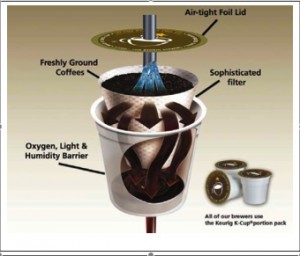If you have found this website you are obviously have asked the question How Does a K Cup Coffee Maker Work? You might be asking your self what makes this coffee brewing method any different than all the other brewing methods. Do you love coffee but get tired of the mess? Frustrated with dirty coffee filters? Want to maintain a quality cup of coffee without the hassle? A K Cup coffee maker might be for you. The technology surrounding this brewer is simply amazing. So grab a cup of coffee and read on to find out what the fuss is all about.
K Cup Coffee Maker Technology
 First lets explain the actual make up of the K cup and what makes it unique. The K cup is a plastic container that is more complex than it actually looks at first glance. In side the plastic cup is first placed a oxygen, light, and humidity barrier that wraps the inner side wall of the cup.
First lets explain the actual make up of the K cup and what makes it unique. The K cup is a plastic container that is more complex than it actually looks at first glance. In side the plastic cup is first placed a oxygen, light, and humidity barrier that wraps the inner side wall of the cup.
This barrier plays an important role in maintaining the freshness of the coffee. Next a sophisticated coffee filter is placed inside of the barrier. This filter helps control the water pressure and ensures ideal extraction time. Now the premeasured freshly ground coffee is placed and packed tightly into the filter. The plastic cup is then sealed with an airtight foil lid that locks in the freshness and taste of the coffee. This patented technology can maintain the coffee freshness and ensure a quality cup for more than six months.
The Key Components of a K-Cup Coffee Maker
Before we can unravel the brewing process, let’s first understand the main components that make up a K-Cup coffee maker:
Water Reservoir: This is where you pour the water needed for brewing. It’s usually located at the back or side of the machine and comes in various sizes, depending on the model.
Pump: K-Cup coffee makers are equipped with a pump that pressurizes the water. The pump plays a crucial role in ensuring that the water flows through the system effectively.
Heating Element: To brew coffee, you need hot water. The heating element in a K-Cup coffee maker is responsible for heating the water to the optimal brewing temperature, typically between 195°F and 205°F (90°C to 96°C).
K-Cup Holder: This is where the magic happens. The K-Cup holder punctures the coffee pod, allowing water to flow through it, and then directs the brewed coffee into your cup.
Drip Tray: Located below the K-Cup holder, the drip tray catches any excess coffee or water that may spill during the brewing process.
Control Panel: Many K-Cup coffee makers come with a control panel or buttons that allow you to customize the brew strength, cup size, and sometimes even the temperature.
The Brewing Process Unveiled
Now that we’ve identified the key components, let’s dive into the step-by-step brewing process:
Water Heating: When you power on your K-Cup coffee brewer and select your brew settings, the heating element starts warming up the water from the reservoir. It takes only a minute or two to reach the desired temperature.
K-Cup Placement: After the water is heated, you open the lid and insert your chosen K-Cup pod into the K-Cup holder. This is where the coffee grounds are sealed within airtight packaging to maintain freshness.
Puncture and Brew: Once you close the lid, the K-Cup holder punctures the foil lid and the bottom of the pod. Hot water is then forced through the punctured hole in the K-Cup and into the grounds inside. This creates a pressurized brewing environment, similar to an espresso machine.
Brewing Time: The hot water extracts flavor from the coffee grounds as it passes through. The brewing time can vary depending on the selected cup size and strength, but it typically ranges from 30 seconds to 1 minute.
Dispensing: As the coffee brews, it flows through a filter in the K-Cup holder and into your waiting cup. The coffee is dispensed in a controlled stream to prevent splashing.
Enjoy: Now Your freshly brewed cup of coffee is ready to enjoy. Simply add your preferred creamer or sweetener, and you’re all set.
Cleaning and Maintenance
To keep your K-Cup coffee maker functioning optimally, regular cleaning and maintenance are essential:
Drip Tray and Reservoir: Empty and clean the drip tray and water reservoir regularly to prevent mold or mineral buildup.
Descaling: Over time, mineral deposits can accumulate in the machine. Descaling solutions are available to remove these deposits and ensure your coffee maker continues to produce great-tasting coffee.
K-Cup Holder: Remove and clean the K-Cup holder periodically to prevent coffee residue from clogging the puncture needle.
Conclusion
K-Cup coffee makers have simplified our morning routines, making it easy to enjoy a variety of coffee flavors with minimal effort. Understanding how these machines work, from heating water to brewing and dispensing, can help you appreciate the technology behind your daily cup of joe. So the next time you brew a fresh cup of K Cup Coffee, you’ll have a deeper appreciation for the science and engineering that make it all possible. Happy brewing
